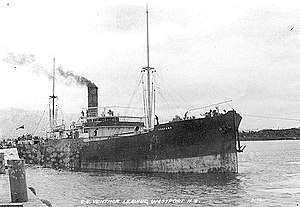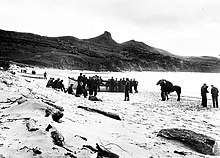SS Ventnor
SS Ventnor was a steamer built in Glasgow in 1901. It sank off New Zealand in 1902, leading to the deaths of 13 crew and the loss of 499 bodies of gold miners which were being repatriated to southern China.[3][4][5][6] This led to the end of the practice of exhuming and returning human remains, en masse, to China from New Zealand.[5][7]
 | |
| History | |
|---|---|
| Name: | Ventnor |
| Owner: | Gow, Harrison & Co. |
| Operator: | Ventnor S.S. Co. |
| Builder: | Russell & Co., Port Glasgow |
| Yard number: | 469 |
| Launched: | 23 January 1901 |
| Homeport: | Glasgow |
| Identification: |
|
| Fate: | Sank (1902) |
| General characteristics | |
| Type: | Cargo Ship |
| Tonnage: | |
| Length: | 344 ft 7 in (105.03 m)[1] |
| Beam: | 49 ft 8 in (15.14 m)[1] |
| Depth: | 18 ft 0 in (5.49 m)[1] |
| Installed power: | 346 Nhp[2] |
| Propulsion: | Rankin & Blackmore 3-cylinder triple expansion |
Final voyage

The charitable association Cheong Sing Tong chartered the Ventnor to return the remains of 499 bodies exhumed from 40 cemeteries in New Zealand to their homes in southern China.[5][7] These men, mostly gold miners, were from the Poon Yu, Seyip, Jung Seng and Dongguan districts.[5] The rest of the cargo was listed as "5347 tons of coal for the Admiralty at Hong Kong, 144 sacks and 22 bales of fungus, one bale of tow and one bale of flax".[8]
The Ventnor left Wellington for Hong Kong on 26 October 1902.[3][4][9] At about 12:30 am the next morning it struck a reef off Cape Egmont[10] leading to damage.[11] It was decided to continue to Auckland instead of returning to Wellington.[12] The ship sank about 16 kilometres (9.9 mi) off the coast, in 147-metre-deep (482 ft) water, near Hokianga Heads on 27 October at 8:45 pm.[13][14][15] Most of the crew made it ashore, but 13 were killed as a life boat capsized.[7][15] None of the Chinese bodies were recovered initially.[16]
Aftermath
The conclusion of a magisterial inquiry given on 19 November 1902 found that the sinking occurred due to either negligence or incompetence. It was found that drunkenness could not be proven and that while the captain and master made good decisions after striking the reef, the blame for the striking lay with the captain alone.[10]
Over the next few months after the sinking, the remains of the Chinese gold miners began to be washed ashore. The local Māori tribe (Te Roroa) buried their remains near their own burial grounds.[16] Cheong Sing Tong hired the Energy to try to find the wreck and recover the bodies, but the wreck remained lost for over 100 years. Remains were repatriated to China for many years after the sinking on an individual basis, but the Ventnor was the last attempt at a mass shipment.[5]
In 2007 a connection was formalised between Te Roroa and the descendants of the Chinese gold miners.[9] A grove of 22 kauri trees were planted and a Chinese gate constructed to memorialise the sinking.[8] The wreck was discovered in 2012 and is now a National Heritage Site.[12][17][18]
The Bone Feeder is an opera featuring the story of the Ventnor. It was composed by Gareth Farr to a libretto written by Renee Liang (and developed from her 2009 play of the same name) which incorporates text in the English, Cantonese and Māori languages.
In June 2020 a documentary crew caused a controversy due to their filming of the wreckage. [19][20]
See also
References
- "The vessel and her gruesome freight", The Star, 29 October 1902, p. 3.
- "Wreck of the Ventnor". The Star, 29 October 1902, p. 3.
- patrice.dougan@nzherald.co.nz @PatriceDougan, Patrice Dougan Assistant Chief of Staff, NZ Herald (18 November 2014). "112-year-old SS Ventnor shipwreck mystery revealed". ISSN 1170-0777. Retrieved 29 April 2019.
- "'Emotional moment' as shipwreck of SS Ventnor found". TVNZ. Retrieved 29 April 2019.
- "SS Ventnor". otago.nzchinese.org.nz. Retrieved 29 April 2019.
- "Peace at last for shipwreck's 'hungry ghosts'". Ramblings. 15 May 2018. Retrieved 29 April 2019.
- "The Lost Voyage of 499". New Zealand Geographic. Retrieved 29 April 2019.
- "Ceremony Honours Remains of Chinese Goldminers – Community/General, News, Society". NZEDGE. 14 May 2013. Retrieved 28 April 2019.
- "Wandering with Ancestors" (PDF). www.northlandnz.com. 2019.
- "The wreck of the S.S. Ventnor". West Australian (Perth, WA : 1879–1954). 21 November 1902. p. 5. Retrieved 29 April 2019.
- "Wreck of the S.S. Ventnor". paperspast.natlib.govt.nz. 1902.
- "112 year old shipwreck of SS Ventnor Finally Found – November 2014 – Latest News Blog // Hands On History". www.handsonhistory.co.nz. Retrieved 28 April 2019.
- "100-Year Old Tragedy of 499 Lost Miners Premieres on Māori Television". Māori Television. Retrieved 29 April 2019.
- "The Ventnor Project – The Chinese Connection". www.ourhokianga.com. Retrieved 29 April 2019.
- "Shipwreck of SS Ventnor and its dead finally found". Stuff. Retrieved 29 April 2019.
- "Wandering with Ancestors" (PDF). www.northlandnz.com. 2019.
- Fraser, Sophie. "SS Ventnor – New Zealand's deepest dived shipwreck | Dive Magazine". Retrieved 29 April 2019.
- "SS Ventnor wreck found after 112 years". Newshub. 18 November 2014. Retrieved 29 April 2019.
- "New opera's rich tapestry". Radio New Zealand. 24 January 2017. Retrieved 28 April 2019.
- "Inspired By Ancestral Loss – Arts, News, Theatre". NZEDGE. 18 November 2011. Retrieved 28 April 2019.